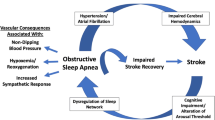Abstract
More than two thirds of stroke patients suffer from sleep apnea. A recent study showed that mirtazapine reduced the respiratory disturbance index (RDI) of a stroke patient by 80%. These promising results prompted us to offer mirtazapine to non-depressed stroke patients who suffered from sleep apnea and refused treatment with a continuous positive airway pressure (CPAP) device. Polysomnography was performed between 2200 and 0600 hours. We examined ten inpatients [nine male, one female; mean age of 68.7 ± 1.5 years ± SE; body mass index of 26.1 ± 1.2 kg/m2, basal ganglia bleeding (n = 3), middle cerebral artery ischemia (n = 4), basal ganglia ischemia (n = 1), cerebellar bleeding (n = 2)] in the Neurologic Clinic’s sleep laboratory. The mean duration of illness before the first polysomnography was 52.6 ± 11.4 days. Mirtazapine effectively consolidated sleep in all patients, i.e., sleep efficiency significantly increased from 63.1 ± 4.8% to 75.7 ± 5.0%. A moderate increase in RDI (137.4 ± 15.3% of baseline) occurred during initial mirtazapine administration (intake duration 15.8 ± 5.5 days). After 51.9 ± 8.4 days, the RDI was either reduced (51.9% in “responders” who were identified arbitrarily by a reduction in RDI ≥ 25% at any time point of the investigation) or increased (154.4% in “non-responders”). Mirtazapine administration was stopped in the four patients with increased RDI. Mirtazapine may be a probably effective treatment in stroke survivors with obstructive sleep apnea who refuse nasal CPAP treatment. As it may worsen central and mixed sleep apnea, patients who receive mirtazapine to alleviate sleep apnea or to control post-stroke depression with sleep disturbances should be monitored for changes in breathing parameters during sleep.



Similar content being viewed by others
References
Murray CJ, Lopez AD (1997) Alternative projections of mortality and disability by cause 1990–2020: global burden of disease study. Lancet 349:1498–1504
Bassetti C, Aldrich MS (1999) Sleep apnea in acute cerebrovascular disease: final report on 128 patients. Sleep 22:217–223
Good DC, Henkle JQ, Gelber D, Welsh J, Verhulst S (1996) Sleep-disordered breathing and poor functional outcome after stroke. Stroke 27:252–259
Palombini L, Guilleminault C (2006) Stroke and treatment with nasal CPAP. Eur J Neurol 13:198–200
Castillo JL, Menendez P, Segovia L, Guilleminault C (2004) Effectiveness of mirtazapine in the treatment of sleep apnea/hypopnea syndrome (SAHS). Sleep Med 5:507–508
Mendelson W, Maczaj M, Holt J (1991) Buspirone administration to sleep apnea patients. J Clin Psychopharmacol 11:71–72
Yoshioka M, Goda Y, Togashi H, Matsumoto M, Saito H (1992) Pharmacological characterization of 5-hydroxytryptamine-induced apnea in the rat. J Pharmacol Exp Ther 26:917–924
Redline S, Lester Kirchner HL, Quan SF, Gottlieb DJ, Kapur V, Newman A (2004) The Effects of Age, Sex, Ethnicity, and Sleep-Disordered Breathing on Sleep Architecture. Arch Intern Med 164:406–418
Mahoney F, Barthel D (1965) Functional evaluation: the Barthel Index. Md State Med J 14:61–65
Jasper HH (1958) The ten-twenty electrode system of the International Federation. Electroencephalogr Clin Neurophysiol 10:371–375
Rechtschaffen A, Kales A (1968) A manual of standardized terminology, techniques and scoring system for sleep stages of human subjects. UCLA Brain Information Service, Brain Research Institute, Los Angeles
The Report of an American Academy of Sleep Medicine Task Force (1999) Sleep-related breathing disorders in adults: recommendations for syndrome definition and measurement techniques in clinical research. Sleep 22:667–689
Marin JM, Carrizo SJ, Vicente E, Agusti AGN (2005) Long-term cardiovascular outcomes in men with obstructive sleep apnoea–hypopnoea with or without treatment with continuous positive airway pressure: an observational study. Lancet 365:1046–1053
Fietze I, Dingli K, Diefenbach K, Douglas NJ, Glos M, Tallafuss M, Terhalle W, Witt C (2004) Night-to-night variation of the oxygen desaturation index in sleep apnoea syndrome. Eur Respir J 24:987–993
Abad VC, Guilleminault C (2006) Pharmacological management of sleep apnoea. Expert Opin Pharmacother 7:11–23
DeVane C (1998) Differential pharmacology of newer antidepressants. J Clin Psychiatry 59(Suppl. 20):85–93
deBoer T (1996) The pharmacologic profile of mirtazapine. J Clin Psychiatry 57(Suppl. 4):19–25
Parra O, Arboix A, Bechich S, García-Eroles L, Montserrat JM, López JA, Ballester E, Guerra JM, Sopena JJ (2000) Time course of sleep-related breathing disorders in first-ever stroke or transient ischemic attack. Am J Respir Crit Care Med 161:375–380
Carley DW, Olopade C, Ruigt GS, Radulovacki M (2007) Efficacy of mirtazapine in obstructive sleep apnea syndrome. Sleep 30:35–41
Acknowledgments
The author wishes to thank D. Dervic, I. Eichardt, A. Habenicht, B. Heinen, B. Rosenlehner, and M. Schroeder for their excellent technical assistance.
Author information
Authors and Affiliations
Corresponding author
Rights and permissions
About this article
Cite this article
Brunner, H. Success and failure of mirtazapine as alternative treatment in elderly stroke patients with sleep apnea—a preliminary open trial. Sleep Breath 12, 281–285 (2008). https://doi.org/10.1007/s11325-008-0177-7
Received:
Revised:
Accepted:
Published:
Issue Date:
DOI: https://doi.org/10.1007/s11325-008-0177-7




